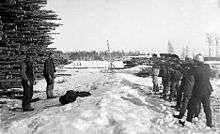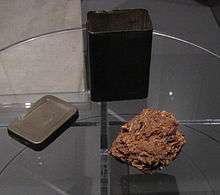Finnish Civil War prison camps

Finnish Civil War prison camps were operated by the White side of the 1918 Finnish Civil War. They were composed of 13 main camps, mostly active from the April–May 1918, and more than 60 smaller POW camps at the final period of the war. Number of captured Red Guard members and associates was approximately 80,000[1] including 4,700 women[2] and 1,500 children.[3] A total of 12,000–14,000 prisoners died in captivity. Camps and their hopeless conditions effected in the minds of many people much deeper than the bloody war itself,[1] although the camps were totally ignored for decades by the White interpretation of the Civil War history.[4]
Establishment
The first prison camps were established at the early stages of war in the White controlled Northern part of Finland.[5] These camps also held 5,000 soldiers of the Imperial Russian Army.[6] In the late March, the number of Red prisoners was only 4,000[2] but after the Battle of Tampere on 5 April 1918, some 11,000 Red Guard soldiers fell into the hands of the Whites and the first large camp was established in the Kalevankangas district of Tampere.[7] Before the Tampere battle, the captured Reds had mostly been shot, but after the collapse of Tampere the number of prisoners was much too large to carry on the executions.[8]
During the late April, thousands of refugees and Red Guard members headed east towards the Russian border. More than 30,000 were captured by the White troops and the German Baltic Sea Division between the towns of Hämeenlinna and Lahti. 22,000 of them were held for a couple of weeks on a concentration camp founded at the Fellman mansion premises in Lahti.[9] Women and children were mainly released, but 10,900 male refugees and Red Guard members were moved to the Hennala prison camp. Finally, as the war ended on 15 May, around 80,000 Reds were held in more than 60 small camps. During next two months all prisoners were transferred to 13 main camps, located mostly in the southern parts of country.
Executions and the Political Offence Court

Before the establishment of the Political Offence Court (Valtiorikosoikeus), more than 5,000 capitulated Reds were shot by the decisions of the local Court-martials.[8] The mass executions had started in February under the instructions given by the Commander-in-Chief Carl Gustaf Emil Mannerheim.[10] Court-martials divided the prisoners into three groups: first group included Red Guard leaders and members of the Red administration as well as all Reds accused of war crimes like murders, arson and looting. They were mostly given death penalties. The second group consisted of all other Red Guard members and associates who were given prison sentences. Third group was categorized innocent and released.[5]
Mass executions were finally ceased by commander Mannerheim's order and the Political Offence Court was established in the late May.[1] It was composed of 145 separate courts which handled more than 75,000 cases.[11] The Senate made a decision to keep the prisoners detained until each person's guilt could be examined. Capital punishment was given for 555 Reds but only 113 were executed, as it was possible to plea for mercy.[8]
The notorious Estonian-born war criminal Hans Kalm alone was responsible of more than 500 executions at the Hennala prison camp in Lahti. At least 200 of his victims were women[7] and the youngest of them were only 14 years old. 104 of the 1,482 children held in prison camps died. Most of them died of starvation or disease but some 20 were executed, the youngest being only 9-year-old boy.[3]
Living conditions in the camps
Conditions in the camps were terrible, general hygiene was bad and there was a lack of food supplies as the prisoners were not allowed to receive deliveries from their families before the end of August. Prisoners died of malnutrition and various disease like relapsing fever, pneumonia, dysentery and smallpox.[2] The most lethal was the Spanish influenza which caught Finland in July.[11] Viljo Sohkanen, who was held at the Suomenlinna prison camp, described the conditions:[2]
″Prisoners got a half a plate of soup, muddy water with a shred of cabbage, and some fat during the days and a small piece of bread with a stinky brown herring during the evenings. Soon we ate every plant we could find from the yard and the roots too. Some found angleworms and in Tampere, a half-rotten horse was eaten raw. One prisoner got sausage in a packet from home. He ate it all, but then threw it up in big pieces. Others immediately started eating the thrown-up sausage.″

The most infamous camp was the Tammisaari prison camp in Ekenäs. During the summer, an average of 30 prisoners died every day, making the total number of deceased up to 3,000 with a mortality rate of 34%. In August, the Finnish medical scientist Robert Tigerstedt made a secret report of the prison camps. According to his report ″...such a death rate was never seen before and nothing like that could have happened even during the times of Czarist Russia.″ Tigerstedt's report was leaked to the Swedish press by Finnish Social Democrats and it soon spread to other Scandinavian countries and Great Britain. It is assumed that the report influenced negatively for the general attitude to acknowledge the Independence of Finland. A common rumor says that some foreign powers demanded Finland to improve the conditions of the prison camps or they would postpone their recognition of Finland's independence.[11]
Another famous case was the businessman Hjalmar Linder, one of the wealthiest men in Finland. He made a visit to the Suomenlinna camp to see some of his employees and was shocked. Linder wrote a letter to the Swedish language newspaper Hufvudstadsbladet saying ″the Red Madness has turned into a White Terror as people are dropping dead like flies″.[4] He insisted the prisoners should be released immediately and suggested that they should work a couple of years for their former employers as a forced labor.[12] Linder's humane writings were deeply condemned by the Whites, he was seen as a Red associate and soon the hatred became so hard he had to flee the country.[13]
Amnesties
The camp conditions finally got better in the mid-September, as the management was transferred from the White Army to the State Correctional Office. At the same time nearly 40,000 prisoners were released on parole and in October 10,000 more were pardoned. During the late 1918 five camps were closed and the rest worked as labor camps until 1921.[4] At the end of 1919 the number of prisoners was 4,000 and 3,000 were pardoned in January 1920. As the labor camps were closed in 1921, the last 100 prisoners were transferred to Tammisaari camp. The last 50 Reds were released in 1927 and Tammisaari was turned into a penitentiary for political prisoners. It was finally closed 1940. In 1973, the Finnish government paid reparations to 11,600 persons imprisoned in the camps after the civil war.[14]
List of the main camps
The number of prisoners is based on the book ″Vankileirit Suomessa 1918″ (1971) by the historian Jaakko Paavolainen. Casualties are based on the War Victims of Finland 1914–1922 Internet Database unless otherwise cited.
| Camp | Location | Number of prisoners[15] | Casualties[16] | Note |
|---|---|---|---|---|
| Tammisaari prison camp | Dragsvik, Ekenäs | 8,689 | 2,997 | a labor camp for political prisoners until 1940 |
| Hämeenlinna prison camp | Hämeenlinna | 11,482 | 2,464 | |
| Tampere prison camp | Tampere | ca. 10,000 | ca. 1,400 | a labor camp until early 1919 |
| Hennala prison camp | Lahti | ca. 10,900 | 1,187 | a labor camp until October 1919 |
| Suomenlinna prison camp | Suomenlinna, Helsinki | ca. 10,000 | ca. 1,400[17] | a sub-camp for Helsinki Prison Camp, a labor camp until 14 March 1919 |
| Riihimäki prison camp | Riihimäki | 8,495 | 981 | a labor camp until 1921 |
| Vyborg prison camp | Vyborg | 10,350 | 834 | consisted of four sub-camps |
| Lappeenranta prison camp | Lappeenranta | ca. 3,000 | 692 | |
| Kuopio prison camp | Kuopio | 2,639 | 476 | |
| Isosaari prison camp | Isosaari, Helsinki | ca. 340[17] | a sub-camp for Helsinki Prison Camp | |
| Turku prison camp | Turku | 3,300 | 176 | a labor camp until July 1919 |
| Oulu prison camp | Oulu | 2,1001 | 49[18] | |
| Vaasa prison camp | Vaasa | 924 | 15 | |
| Santahamina prison camp | Santahamina, Helsinki | ca. 3,0002 | 13[17] | a sub-camp for Helsinki Prison Camp |
| Mikkeli prison camp | Mikkeli | 778 | 11 | |
| Katajanokka prison camp | Katajanokka, Helsinki | a sub-camp for Helsinki Prison Camp |
- 1 ca. 1,000 Russian soldiers until July 1918
- 2 ca. 2,000 male prisoners (April–May 1918), ca. 1,000 female prisoners (June–September 1918)
Sources
- Tepora, Tuomas & Roselius, Aapo: The Finnish Civil War 1918: History, Memory, Legacy. Brill Academic Publishers 2014. ISBN 978-900-42436-6-8. Google Books
References
- 1 2 3 Red Prisoners MANNERHEIM – War of Independence. Retrieved 9 February 2015.
- 1 2 3 4 The Victims of the Finnish Civil War University of Tampere. Retrieved 9 February 2015.
- 1 2 "Story of children lost in Finland's civil war". Finland Times. 29 March 2014. Retrieved 9 February 2015.
- 1 2 3 Tepora & Roselius, p. 116–117.
- 1 2 Tepora & Roselius, p. 111.
- ↑ Suomi 1917–1918 – Vankileirit (in Finnish) University of Tampere. Retrieved 9 February 2015.
- 1 2 Prison camps in Finland Pala Suomen historiaa. Retrieved 9 February 2015.
- 1 2 3 Tepora & Roselius, p. 108–110.
- ↑ Fellmanin pelto 1918 (in Finnish) Lahti Art Museum. Retrieved 9 February 2015.
- ↑ Gerwarth, Robert & Horne, John: War in Peace: Paramilitary Violence in Europe after the Great War, p. 80–81. Oxford University Press 2013. ISBN 978-019-96549-1-8. Google Books
- 1 2 3 Tepora & Roselius, p. 113–115.
- ↑ Linder, Hjalmar: Nog med blodbad! (in Swedish) Hufvudstdsbladet Archive. Retrieved 10 February 2015.
- ↑ "Hjalmar Linder – ihmisyyden ääni keväällä 1918" (in Finnish). Suomen Kuvalehti. 26 May 2008. Retrieved 10 February 2015.
- ↑ Vuoden 1918 kronologia (in Finnish) The Labor Archive. Retrieved 10 February 2015.
- ↑ Paavolainen, Jaakko: Vankileirit Suomessa 1918, p. 111. Tammi 1971.
- ↑ Vuosina 1914-22 sotaoloissa surmansa saaneiden nimitiedosto War Victims of Finland 1914–1922 Database. Retrieved 10 February 2015.
- 1 2 3 Punaisten muistomerkit – Helsinki (in Finnish) Labor Museum Werstas. Retrieved 10 February 2015.
- ↑ Ala-Häivälä, Kai: Vankina valkoisten – Oulun vankileiri 1918 p. 29. (in Finnish) University of Helsinki 2000. Retrieved 10 February 2015.